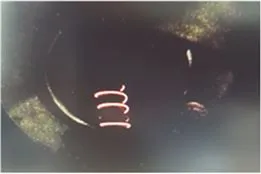Abstract
(ed comment: This is proof of unlimited nuclear energy without a radiation hazard at near room temperature)
Academic Editor: Alberto Pettinau
Received: 9January2025
Revised: 6February2025
Accepted: 6February2025
Published: 12 February2025
Citation: Alexandrov, D.
Energy Release in Deuterium–Constantan
Interactions. Energies 2025, 18, 856.
https://doi.org/10.3390/
en18040856
Department of Electrical Engineering, Faculty of Engineering, Lakehead University, Thunder Bay, ON P7B 5E1, Canada
Energy Release in Deuterium–Constantan Interactions
A significant energy release over a short time is achieved in replicable experiments involving the interaction of deuterium gas with constantan specimens. The experiments were carried out in a gas chamber where the injected deuterium interacted with heated specimens: (i) Many replicable experiments were performed at initial temperatures in the range of 666–681 °C. The temperatures of the specimens began to increase ~8 s after the beginning of deuterium injection as additional increases of 358–382 °C reached after ~30 s. The released excess power was in the range of 183–209 W, its density ranged from ~114–130 W/g, and the ratio of (output power)/(input power) was ≈ 3.76–3.91. (ii) Several replicable experiments were performed at initial temperatures of 950 °C. In all these experiments, explosive evaporation of the wires occurred immediately after the beginning of deuterium injection. The released excess momentary power was greater than 3400 W, its density was 2280 W/g, and the ratio of (output power)/(input power) was ≈ 16 and greater. The outcomes found were as follows: (a) the released excess power was not of electrical origin; (b) the released excess power of chemical origin was less than ~0.18% of the total released excess power; (c) the significant density of the released excess power; and (d) helium release, correlating with the energy release, was observed.
The conclusion that the released energy is of nuclear origin was drawn.


5. Conclusions
Successful experiments of LENR reactions in constantan wire are reported in this paper. The following experimental outcomes are achieved: (i) the experiments are replicable, and they are of two types—one which destroys the wire and one which does not. In the second type, the same constantan wire can be used in multiple experiments; (ii) a significant energy release for a short time (~30 s); (iii) the significant density of the released energy in terms of the mass of the constantan wire; and (iv) the release of helium gas (both isotopes 3He and 4He), which correlates with the energy release. The author considers that thanks to the experimental scheme introduced in the paper, the above experimental outcomes have been achieved for the first time in LENR research.
Supplementary Materials: The following supporting information can be downloaded at:
https://www.mdpi.com/article/10.3390/en18040856/s1,
Video S1. F-reaction in constantan.
Funding: This research received no external funding.
Data Availability Statement: The original contributions presented in this study are included in the
article. Further inquiries can be directed to the corresponding author.
Conflicts of Interest: The Author declares no conflict of interest